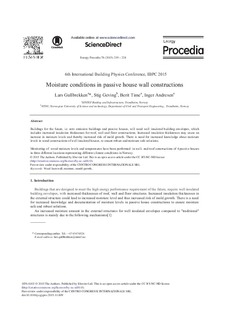| dc.contributor.author | Gullbrekken, Lars | |
| dc.contributor.author | Geving, Stig | |
| dc.contributor.author | Time, Berit | |
| dc.contributor.author | Andresen, Inger | |
| dc.date.accessioned | 2016-01-08T12:15:51Z | |
| dc.date.accessioned | 2016-02-08T14:15:26Z | |
| dc.date.available | 2016-01-08T12:15:51Z | |
| dc.date.available | 2016-02-08T14:15:26Z | |
| dc.date.issued | 2015 | |
| dc.identifier.citation | Energy Procedia 2015, 78:219-224 | nb_NO |
| dc.identifier.issn | 1876-6102 | |
| dc.identifier.uri | http://hdl.handle.net/11250/2377401 | |
| dc.description.abstract | Buildings for the future, i.e zero emission buildings and passive houses, will need well insulated building envelopes, which includes increased insulation thicknesses for roof, wall and floor constructions. Increased insulation thicknesses may cause an increase in moisture levels and thereby increased risk of mold growth. There is need for increased knowledge about moisture levels in wood constructions of well insulated houses, to ensure robust and moisture safe solutions.
Monitoring of wood moisture levels and temperatures have been performed in wall- and roof constructions of 4 passive houses in three different locations representing different climate conditions in Norway. | nb_NO |
| dc.language.iso | eng | nb_NO |
| dc.publisher | Elsevier | nb_NO |
| dc.title | Moisture Conditions in Passive House Wall Constructions | nb_NO |
| dc.type | Peer reviewed | nb_NO |
| dc.type | Journal article | en_GB |
| dc.date.updated | 2016-01-08T12:15:51Z | |
| dc.source.volume | 78 | nb_NO |
| dc.source.journal | Energy Procedia | nb_NO |
| dc.identifier.doi | 10.1016/j.egypro.2015.11.609 | |
| dc.identifier.cristin | 1308615 | |
| dc.description.localcode | © 2015 The Authors. Published by Elsevier Ltd. This is an open access article under the CC BY-NC-ND license. | nb_NO |
